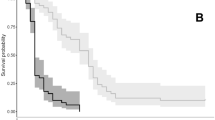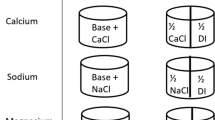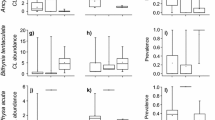Summary
A comparative study of egestion in three species of mud snails under controlled conditions of salinity ranging from 10 to 30‰, and temperatures ranging from 5 to 35°C, shows that Hydrobia ulvae has maximal egestion at the combination of high salinity (30‰) and high temperature (30°C). In Hydrobia neglecta a peak of egestion occurs at the combination of 25‰ salinity and 25°C. Hydrobia ventrosa shows a small maximum at 20‰ and 30°C. However, in contrast to the former two species the egestion is rather uniform over the range of salinities and temperatures tested.
Considering egestion as a measure of activity at combined temperature and salinity, there is a moderate degree of overlap of this niche axis. The often observed co-existence of the three species is discussed in relation to the present findings and other evidence illustrating the width of the niches. It is concluded that co-existence, in spite of interspecific competition, is possible provided the environment is sufficiently unpredictable.
Similar content being viewed by others
References
Brenko, M. H., Calabrese, A.: The combined effects of salinity and temperature on larvae of the mussel Mytilus edulis. Mar. Biol. 4, 224–226 (1969)
Dennert, H. G.: Tolerance differences and interspecific competition in three members of the amphipod genus Gammarus. Bijdragen tot de Dierkunde 44, 83–99 (1974)
Fenchel, T.: Factors determining the distribution patterns of mud snails (Hydrobiidae). Oecologia (Berl.) 20, 1–17 (1975a)
Fenchel, T.: Character displacement and coexistence in mud snails (Hydrobiidae). Oecologia (Berl.) 20, 19–32 (1975b)
Harger, J. R. E.: Competitive co-existence: maintenance of interacting associations of the sea mussels Mytilus edulis and Mytilus californianus. The Veliger 14, 387–410 (1972)
Hutchinson, G. E. L.: Concluding remarks. Cold Spr. Harb. Symp. quant. Biol. 22, 415–427 (1957)
Hylleberg, J.: Competition for food on basis of selectivity in feeding and digestive enzymes in deposit feeding mud snails (Hydrobiidae). In preparation
Hylleberg, J., Lassen, H. H.: The effect of abiotic factors on activity, respiration and survival in mud snails (Hydrobiidae). In preparation
Jaeger, R. G.: Competitive exclusion: comments on survival and extinction of species. Bio Sci. 24, 33–39 (1974)
Jansson, B.-O.: Salinity resistance and salinity preference of two oligochaetes Aktedrilus monospermatecus Knöller and Marionina preclitellochaeta n.sp. from the interstitial fauna of marine sandy beaches. Oikos 13, 293–305 (1962)
Levins, R.: Evolution in changing environments. Monographs in population biology, 120 pp. Princeton: Princeton University Press 1968
MacArthur, R. H.: Geographical ecology. Patterns in the distribution of species, 269 pp. New York: Harper and Row 1972
MacNaughton, S. J., Wolf, L. L.: Dominance and the niche in ecological systems. Science 167, 131–139 (1970)
Manzi, J. J.: Combined effects of salinity and temperature on the feeding, reproductive, and survival rates of Eupleura caudata (Say) and Urosalpinx cinerea (Say) (Prosobranchia: Muricidae). Biol. Bull. 138, 35–46 (1970)
Miller, R. S.: Pattern and process in competition. In: Advances in ecological research, vol. 4, p. 1–74, J. B. Cragg, ed. New York: Academic Press 1967
Moore, C. G., Fisher, B. R.: Competition in mosquitoes. Density and species ratio effects on growth, mortality, fecundity, and production of growth retardant. Ann. Entomol. Soc. Amer. 62, 1325–1331 (1969)
Muus, B. J.: The fauna of Danish estuaries and lagoons. Medd. Danm. Fisk. Havunders. N.S. 5, 1–316 (1967)
Newell, R.: The role of detritus in the nutrition of two marine deposit feeders, the prosobranch Hydrobia ulvae and the bivalve Macoma balthica. Proc. Zool. Soc. Lond. 141, 25–45 (1965)
Rasmussen, E.: Systematics and ecology of the Isefjord marine fauna (Denmark). Ophelia 11, 1–495 (1973)
Smidt, E. L. B.: Animal production in the Danish Waddensea. Medd. Danm. Fisk. Havunders. Ser. Fisk. 11, 1–151 (1951)
Tietjen, J. H., Lee, J. J.: Life cycles of marine nematodes. Oecologia (Berl.) 10, 167–176 (1972)
Author information
Authors and Affiliations
Rights and permissions
About this article
Cite this article
Hylleberg, J. The effect of salinity and temperature on egestion in mud snails (Gastropoda: Hydrobiidae). Oecologia 21, 279–289 (1975). https://doi.org/10.1007/BF00345822
Received:
Issue Date:
DOI: https://doi.org/10.1007/BF00345822




